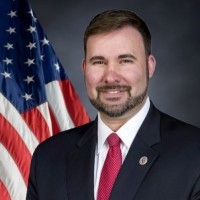State Dept reshaping acquisition organization, processes
Michael Derrios, the senior procurement executive at the State Department, said he’s building acquisition centers across four major lines of business.
From new authorities to an updated organizational structure, the State Department’s acquisition office is going to look much different in the next few years.
State is reorganizing its acquisition efforts around four lines of business:
- Diplomatic security
- Overseas buildings and construction
- Technology, cybersecurity and artificial intelligence
- Professional services
Michael Derrios, the senior procurement executive at the State Department, said the goal of the reorganization is to help agency customers get services from a consolidated and expert group of contracting professionals.

“It helps me with category management. How do we aggregate the demand?” Derrios said at the recent ACT-IAC AI Acquisition Forum. “I love the fact we have the best-in-class vehicles. We use those. But that is not the panacea for category management. Where the rubber really hits the road and where we really save money is when I can go to 10 customers that, in real-time, have a need and a procurement action that is coming in the next couple of months or weeks and say, ‘hey, let’s talk about that. Is there an opportunity smartly aggregate that demand?’ We can approach industry in a means where we can leverage our buying power.”
While that new structure comes into place, Derrios also is giving State’s acquisition workforce new tools and creating new governance bodies to help reduce time to contract award.
One new acquisition approach that all of these new organizations will be able to take advantage of in the coming years is the use of State Department specific federally-funded research and development centers (FFRDCs).
Derrios said State received approval in October to enter into sponsorship agreements and establish direct relationships with FFRDCs.
“It gives us another tool in the toolbox that we just don’t have today. Today we have to go to other agencies and try to get access to their FFRDCs. Now we will be able to have our own suite of FFRDC contractors,” Derrios said in a recent interview on Ask the CIO. “We just didn’t have our own indefinite delivery, indefinite quantity (IDIQ) vehicles with the MITREs, LMIs or RANDs of the world. They provide great service in niche areas. The State Department’s mission is evolving. We are now doing things that the department wasn’t asked to do in year’s past. I think that is the case across the board in all aspects of our mission. The research aspect, especially of R&D, is something we could benefit from.”
State seeking OTA authority
State’s office previously could use other agency’s, such as the Department of Defense, contracts with FFRDCs as long as it met the scope requirements.
But Derrios said scope was only one challenge. Agencies tend to protect the contract ceilings of their FFRDC vehicles so that too limited access.
“The other agencies is going to, and rightfully so, protect the ceiling on their vehicles and when other agencies are eating into that ceilings a bit too much, they back off and say, ‘hey, you need to go somewhere else and get that support,’” he said. “We could be right in the middle of something, and frankly it happened, and had to start over. We want to try to alleviate this problem by having access to our own suite of vehicles.”
Along with FFRDCs, Derrios remains optimistic that Congress will grant State another important acquisition tool: The authority to use other transaction agreements (OTAs).
He said State has asked Congress for permission two years in a row, and would like to see OTAs expanded to all agencies.
“I think the State Department has some very unique needs that we could benefit from OTA authority,” he said. “In our diplomatic security portfolio, for example, the ability to accelerate development of a particular security related product could absolutely help our mission set. The ability to do that with a vendor who may be doesn’t know anything about federal procurement, and, frankly, may not even care about federal procurement, but they would be happy to develop something that they may be using elsewhere, we would love to have that capability more at the Department of State. I’m going to keep at it and see where it goes.”
New governance over large projects
The new acquisition tools and the reorganization are pieces of a larger effort to improve how the State Department manages acquisition more broadly.
Over the last year, Derrios said his office launched an Executive Business Review Council (EBRC) to look at acquisition from the mission and contracting sides.
“We really want to shore up both sides of the house there, and we’re requiring folks at a particular dollar threshold to come forward and talk about their program plans and the infrastructure that they’ve established, including their budgeting, how prepared are they for us to enter into a big contract for them, their acquisition support needs and is there a good acquisition strategy attached to it?” he said. “This EBRC is in a pilot phase right now. We’ve already had a couple of programs go through it successfully, I think, and it’s sparked really good dialogue with a set of executives that have shared equities and the department’s acquisition program.”
The executive council is led by Alaina Teplitz, State’s assistant secretary of the Bureau of Administration and chief procurement officer, and Douglas Pitkin, State’s director of the Bureau of Budget and Planning and program management improvement officer.
Derrios and other senior leaders like Kelly Fletcher, State’s chief information officer, also sit on the council.
“The BRC is a big one for us. It’s a flagship effort to really start to think about how we do major acquisitions differently,” Derrios said. “The threshold [for review] is $250 million and over. So it’s pretty high. We don’t want to clog the system with everything. It’s risk based. At that dollar threshold, we’re expecting program offices to have a more formalized plan and approach for program management. The procurements at that level are usually for systems, which are very complex and/or major services. It’s aimed at catching those things and not creating a bottleneck with lower dollar things.”
State will be putting more large-dollar projects through the ECRB in 2024, capture lessons learned and sharing them across the department.
Derrios said he hopes the benefit of this approach is accelerating acquisition planning and time to award.
State’s new forecast to industry
The other significant governance change that started in 2023 and will expand in this year is around procurement planning.
Derrios said State is doing two things. First, it’s redesigning their forecast tool to make it much more robust. He said industry should be “pretty excited” for the forecast tool’s redesign.
Second, State is putting more thought and efforts in its procurement planning conferences. Derrios hopes to create easier and more often opportunities for program managers, contracting experts and industry to get together to talk about their upcoming needs.
He said, too often, those discussions don’t happen for an assortment of reasons and program folks end up missing out on potential innovations.
“We’re trying to drive that in a formalized process so that all of our customers are getting that same experience. We have very good planning, unfortunately, sometimes it’s in pockets. We’re not leveraging that, I think, to the extent that we should be,” he said. “All of that upfront work needs to happen in order to populate a better forecast for industry to see. We’re trying to build an acquisition ecosystem at the department where it all fits in together. I’ll make the distinction between acquisition planning and procurement planning. Procurement planning is what are the vehicles that we need to put in place for you to meet your needs? The acquisition planning is, ‘hey, so you’re going to be going after a big contract that is delivering capability for the department’s mission, and this program is integral to mission success and the contracts that we’re going to award.’ It’s all connected.”
Copyright © 2025 Federal News Network. All rights reserved. This website is not intended for users located within the European Economic Area.
Jason Miller is executive editor of Federal News Network and directs news coverage on the people, policy and programs of the federal government.
Follow @jmillerWFED







